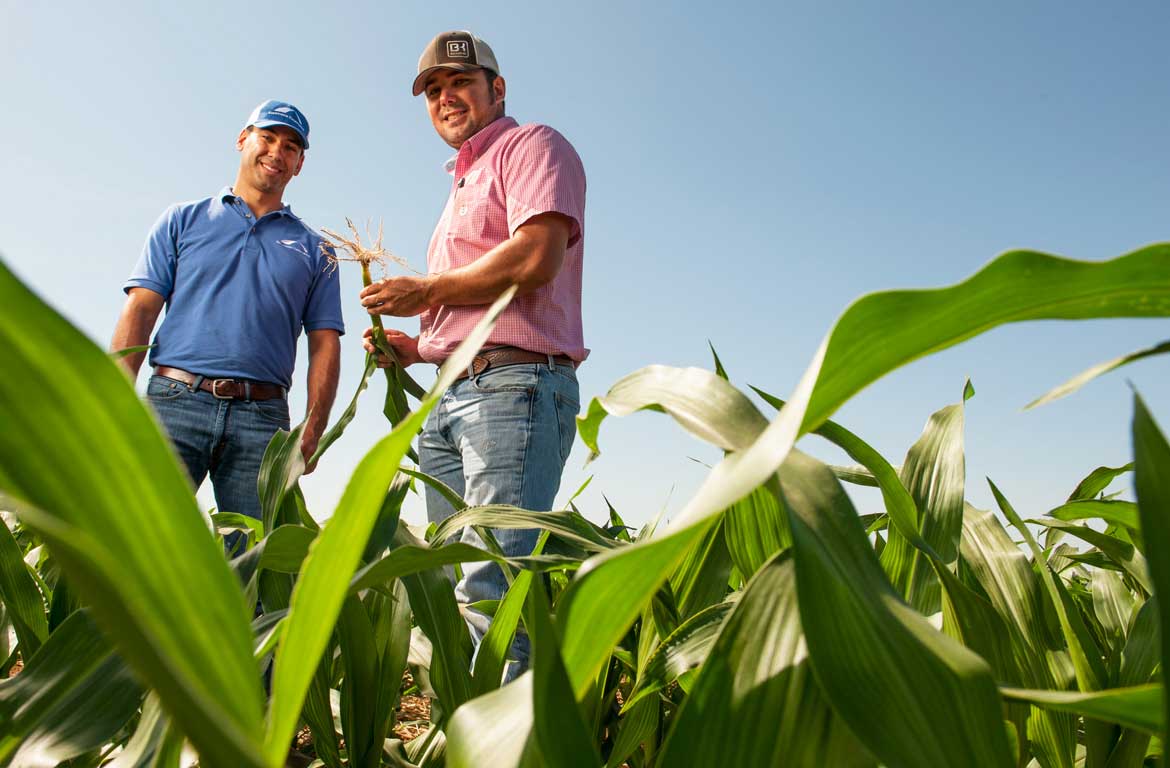
Sustainable Conservation Project Manager John Cardoza (left) and De Jager Farms general manager Nate Ray check out healthy silage corn fertilized with dairy waste water. We're partnering with Nate and Netafim USA to pilot a liquid-manure drip irrigation system that promises a trifecta of benefits for farmers and local communities: improved water efficiency, reduced nitrate leaching, and increased crop yields.

-
Our 2015 test plot showed:
15% increase in crop yield
38% increase in water use efficiency
52% increase in nitrogen use efficiency
Nate Ray knows more hours of the day than most of us. Up at 4:00 each morning, he manages De Jager Farms’ five dairies in Chowchilla, Calif. and tends his own crops before heading home at 7:00 p.m. for dinner with his wife and three children. The days are long but rewarding.
By investing in the land and nutrition of his community, Nate’s helping to ensure the San Joaquin Valley remains a major source of American dairy products – as well as a healthy place to raise his family. A place with clean, sufficient water where crops and kids alike can flourish.
Sustainable Conservation shares the hopes and concerns of Nate, De Jager Farms, and many of you. That’s why, in 2015, we advanced our pilot project with De Jager and Netafim USA, an irrigation technology company, to demonstrate how improved water quality and thriving crops can go hand in hand.
You see, California leads the nation in milk production – churning out not only the protein- and calcium-rich conveyance for your cereal, but much of the butter, cheese, and even ice cream so many of us across the U.S. enjoy. Delivering those products – and their bone-building benefits – requires a lot of cows and a lot of water.
Let’s talk about the cows first. With each Holstein (or Jersey or Brown Swiss) producing around 120 pounds of waste DAILY, dairies are inherently nutrient-rich places. As Nate likes to say, “We’re blessed with excrement,” aka black gold. While indeed an asset, cow manure can also compromise local groundwater and drinking water if not managed properly. Instead of turning to costly synthetics, why not scale the cow pie peaks and avail crops of the natural fertilizer at hand?
Now, on to the water, which dairies need to both feed and clean their bovine workers. Currently, the vast majority of California dairies deliver water and nutrients to the crops they grow for their cows through flood irrigation. Flood irrigation is exactly what it sounds like, so you can picture this method’s inconsistency and imprecision, as well as how all that excess fluid sitting atop fields can potentially drive nitrates down into our groundwater. Moving folks to drip irrigation, which delivers water directly to the base of a plant, makes a lot more sense – especially in the context of California’s ongoing drought.
Sustainable Conservation had a hunch that two challenges could merge into a doubly advantageous solution. What if we figured out how to pipe dairy manure water through a drip irrigation system – thereby addressing both water supply and quality challenges?
In 2014, Netafim had the technology, Nate signed on as our test site partner, you contributed support for the pilot from all corners of the state, and we embarked on an environmental problem-solving adventure together. United in purpose, we made adjustments and watched as water use efficiency and crop yields soared. Check out stunning flyover footage showing De Jager’s test and control fields in the video on this page.
You helped us plant this solution – testing it for the first time on a commercial dairy in 2014, and deepening our research and demonstration at De Jager Farms in 2015. If we can reach wide adoption of this method on dairy farms in California, we’ll see significant reductions in nitrate leaching – a big deal for rural Central Valley communities who rely on groundwater for drinking, cooking, and bathing.
When the Central Valley faces environmental and economic challenges so too does the Golden State, and the U.S., overall. When we address these issues from within our nation’s agricultural cradle, we make huge strides in the stewardship of the land, air, and water upon which our greater food system depends.
-
“Farming is a lifestyle, and it’s not for the faint of heart.”
With your help, we’re working on making life easier for folks like Nate and the Cardoza family, their numerous human and bovine colleagues, and the precious natural resources under their care.
We know Nate would like to take a night off here and there, take his wife on a date to the county fair cattle auction so they can raise a glass together. To good health, happy crops – and a community that supports both. After all, while the dark mornings to come may present new challenges, there’s always reason to celebrate the ways in which Californians unite to solve them.

